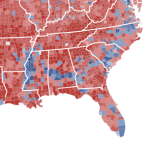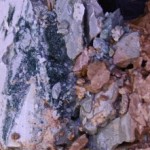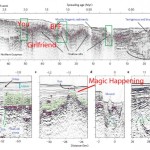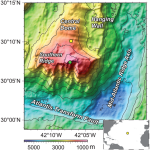The largest unit of defined geologic time is the supereon. Only one is defined, the Precambrian spanning from the formation of the Earth to right before life goes crazy in the Cambrian explosion (4.6 billion years ago to 542 million years ago). Oddly, there is no other supereon after the Precambrian, just the Phanerozoic eon ranging from the Cambrian explosion to the present. The Precambrian can be broken into three eons, Hadean, Acrhaean, and Proterozoic. Life as cyanobacteria first appears in the fossil record 3.5 billion years ago during the Acrhaean. Molecular estimates place life starting around 3.97 billion years ago. Did you get all that?
It doesn’t matter because this is all woefully inadequate. One of the most important events in the Earth’s history, the first appearance of life, does not mark the boundary of major time period. What do we call the entire timespan that life has occurred on Earth? This became issue when colleagues and I published a paper in 2009 describing the evolution of body size over the entire time span of life on earth (pdf). It has the rather gangly title
Two-phase increase in the maximum size of life over 3.5 billion years reflects biological innovation and environmental opportunity
Of course that is better than
Two-phase increase in the maximum size of life over Phanerzoic plus part but not all of the Precambrian reflects biological innovation and environmental opportunity
Or we could have said
Two-phase increase in the maximum size of life over Phanerzoic plus the Archaean and Proterozoic reflects biological innovation and environmental opportunity
Better would be a specific geologic timespan that we can invoke to refer to the time of life on Earth. My coauthors and I think we can fix this.
Behold the Supereon Geozoic (Geo=Earth and zoic=life)! The timespan on Earth sans life? Pregeozoic. The lower boundary would be set by the first appearance of life on Earth, somewhere between 3.8-3.2 billion years ago. The upper boundary cannot be defined until life has gone extinct on our planet. As stated in the paper, “The end point of the Geozoic can be only younger than today: life is still unequivocally present on Earth.”
Of course we also thought of other terms but (quote directly from paper)…”Admittedly, the terms Zoic and Azoic sound like names of evil characters from a low budget sci-fi movie and may thus be not mundane enough to be acceptable as chronostratigraphic terms.” Of course Zoic and Azoic also make no reference to geology and the Earth which we thought vital.
So why do really need the Geozoic?
- Conciseness. Take that title from above. It would have been so much better if it had been Two-phase increase in maximum size over the Geozoic reflects biological innovation and environmental opportunity. Similarly, ‘‘…little evolution at the macroscopic level took place for over half of the entire history of life on Earth’’ (Schulze-Makuch and Irwin, 2004, p. 39) could be ‘‘…little evolution at the macroscopic level took place for over half of the Geozoic’’
- Inadequacy of current terms. For example, how would you currently search for papers and research that examined the entire history of life on earth? Sure would be hand to have a single search term!
- Importance of the life’s origins. Use of the term would place a greater emphasis on the origin of life as a critical temporal event.
- Better organization of education materials. The Geozoic-Pregeozoic terminology would allow for better organization of introductory geological textbooks. From the paper, “In particular, the text dedicated to the origin of life and earliest life is often buried in chapters that deal with the whole Archean or even Archean and Hadean. This problem relates to the lack of explicit separation of the prebiotic and biotic Earth. The Geozoic offers a convenient tool for presenting the Precambrian history of life in a more structured manner in textbooks and in classrooms.”
- For comparisons on life on different planets. If or when we discover life on other plants, we might examine the different evolutionary trajectories on different planets. From the paper, “When we do so, we will need a convenient way to refer to the relevant time period on Earth as well as corresponding terms for other worlds.”
- Most importantly from the paper, “absurdly, we lack a name for the time of life on Earth”
To conclude, we encourage scientists to start using the term Geozoic in scientific publications and for the public to start using it at cocktail parties and water cooler chats
KOWALEWSKI, M., PAYNE, J., SMITH, F., WANG, S., MCSHEA, D., XIAO, S., NOVACK-GOTTSHALL, P., MCCLAIN, C., KRAUSE, R., BOYER, A., FINNEGAN, S., LYONS, S., STEMPIEN, J., ALROY, J., & SPAETH, P. (2011). THE GEOZOIC SUPEREON PALAIOS, 26 (5), 251-255 DOI: 10.2110/palo.2011.S03






Interesting. I need to read the whole argument, but this could work. And perhaps helps sharpen the discussion of both when life begins and what our definition of life is.
What would become of the current Phanerozoic Supereon? Would it be replaced by Geozoic?
Precambrian isn’t really a “supereon,” just an informal name without standing in the working time scale. We don’t need a new supereon, just a new word. The word “geozoic” . . . I dunno. Why not just talk about the “span of life,” until we find life elsewhere and need an Earth-specific word?
The term “Azoic” has already been used a few times.
The time of origin of life is so badly known that I can’t see how it could be used to set a Golden Spike. And no, this is not due to the question of how to define “life”, it’s due to the quality of the record of body fossils and even of chemofossils which is so bad that the question of definition hasn’t even entered the picture so far.
Informal or not, I think there is clear case we need a term. Span of life could work but wouldn’t solve Pt.2. I also think community adoption would be tougher for a phrase rather than a singular term.
In response to the Azoic idea, we argue in the paper that “The term Azoic does not make any reference to Earth.” This would preferred as this is geological age. Likewise, the term azoic is often used generically to refer to any time or even geographic locality void of life. For example, the Azoic hypothesis was a early hypothesis, since refuted, that life was absent in the deep sea. Thus I feel the term azoic would lead to even more confusion.
In response to the second comment about defining the lower boundary. No chronostratigraphic boundary is error free, and time
uncertainties increase with geologic age.
From the paper, “The proposed supereons are not intended to supersede the existing large-scale time units that subdivide the history of Earth into times of macroscopic (Phanerozoic) and dominantly microscopic (Precambrian) life. Rather, they aim to codify our vocabulary by acknowledging the most important event in the history of life.”
What’s the point of an undefinable time scale? There is no way to exclude the presence of life from the early earth. The rock record is fragmentary, and there is no such thing as a “anti-biomarker” which can be used to unequivocally rule out life everywhere on the planet at that time.
Lab Lemming – all our geologic time scales are in some way undefinable! Most divisions in the current geologic time scale are marked by the first appearance of a fossil in a rock somewhere. If you find that fossil in an older rock, then you have to revise your date. This happens with some frequency – the Cambrian boundary has moved around quite a lot over the last 50 years or so (OK true that the boundary is now defined by a “golden spike” in a rock in Newfoundland, but if someone found a sediment-burrowing trace fossil 5 million years older, we’d have to reconsider). It’s true that we will never know *exactly* when life first evolved on the planet, but that doesn’t mean that the geozoic is a bad idea – it’s a useful concept – albeit an imperfect one, like so much in science! Check out this link http://www.stratigraphy.org/forum/viewtopic.php?f=6&t=60006 for a recent example of redefining the geologic timeline.
So, Phanerozoic would be a subdivision of the Geozoic? If so, it seems like we’d need a word for the part of the Geozoic that preceded the Phanerozoic (Microzoic?)
The issue is presented as there being an awkwardness in the paper title, but replacing 3.5 billion years with “Geozoic” doesn’t seem less awkward, infact giving the time range seems much more appropriate.
Can we claim that we’re talking about the Geozoic when we don’t know where the bottom of the Geozoic is, the time span just seems much more sensible. On the other hand, the earliest geologists had no idea what the time ranges were for most of the eras and eons they were dealing with were, and I seem to recall that people would actively go out and look for things like ‘the bottom of’ such and such era (meaning it wasn’t known, and that wasn’t prohibitive).
Come to think of it, isn’t the end of the Hadean the lowest /possible/ limit for the start of life?
Also, Phanerozoic is a great name, why complicate by adding something unnecessary? If one is talking about the pre-biotic world, then use pre-biotic, geology itself doesn’t need a term for this, and if anything geology should be adopting biologies terms: biologists don’t use there own Biological Time Scale.
Just one more thing, since, as far as we know, life might’ve started up, gotten vapourized, started up again, gotten vapourized, (lather, rinse, repeat), then doesn’t Geozoic collapse? The mesozoic couldn’t ‘come back’. Or would the Geozoic start with the first common ancestor for life on earth (and I think LCA wouldn’t work here, no). If so, we would we have the unusual possibility of pre-Geozoic life! Which actually might be a useful term to have.
And I agree, Azoic shouldn’t be used, since it /was/ normally used to refer to the lack of life on the deep sea floor.
Is there a prize for the first person to use Geozoic in a publication that isn’t a discussion of supereons?
there is now!